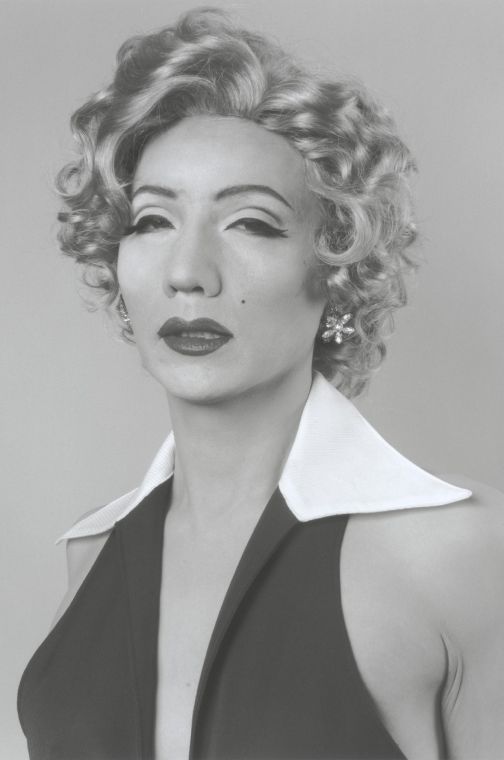Exhibit at The Warhol puts a new face on iconic art
November 20, 2013
There’s always been something appealing and unnerving about an impersonator.
The ability of an Elvis or, more recently, Michael Jackson look-alike to mimic the iconic aspects of a person down to the most minute detail is an entertaining thrill, but the efficient distillation of what made those celebrities so beloved is somewhat eerie.
Such is the case with Yasumasa Morimura’s Theater of the Self. His works utilize the same surreal skill of the impersonator to put a new face — his own — on some of Western culture’s most famed images.
As soon as the elevator to the seventh floor opens, visitors of the Andy Warhol Museum are immediately introduced to overwhelmingly large works that are both unusual and intriguing. Famous pieces from Western history that were once familiar have been restaged piece-by-piece, and they now bear the face of Morimura.
Including photographs, paintings and digital video, Morimura’s exhibit is located on the top floor of the museum through Jan. 12, 2014. It’s held in two rooms filled with enormous images of 20th-century figures such as Hitler and Einstein and works of art such as “Mona Lisa” and “Olympia.”
In every single work, Morimura is the subject. When there is more than one subject, he represents them all.
This is the startling signature of Morimura’s work. With a career spanning 30 years, the artist has produced many different forms of the self-portrait using multiple mediums. During a lecture by the artist at the McConomy Auditorium on Oct. 3, Morimura said that his portraits are a way to “expose his own face and body to many people.”
This unique style was birthed in the ’80s, when he quit making Japanese wood-block prints and began to work on self-portraits. Through reproductions in books and articles, Morimura learned about Western and European artforms and how to reproduce them.
His work with the images of famous figures such as Elvis and Marilyn Monroe have closely connected him to Andy Warhol, and he’s even called himself Warhol’s “conceptual son.” The difference between his and Warhol’s work, however, is that instead of just reproducing the same images with a new spin, Morimura becomes these iconic figures. He recreates the entire scene, mirroring the lighting, postures and style of the original works.
“I think with a lot of the works there is this recognition that takes place, because these are quite well-known images,” said Warhol Museum Milton Curator of Art Nicholas Chambers, who worked in close collaboration with Morimura to exhibit pieces never before seen in the United States.“I think the effect allows people to look at these images in a fresh new way.”
At the lecture, the artist explained that his interest in self-portraits stemmed from a sheltered childhood and a conservative family. His parents had found it hard to accept new things, and their fear for his safety kept him from doing anything outside of his home.
“The only place I could breathe was in my imagination. I created stories and I would be the main character — by myself,” Morimura said.“This is the basis for my self-portraits.”
The exhibition is broken into three distinct categories that look back on his extensive career of self-portraits: “Requiem,” “Art History”and “Actresses.”
The largest room of the exhibit holds the “Requiem” and “Art History” series, which are representations of important scenes from history and re-workings of famous paintings. The large scale of these works allows viewers to see every detail that Morimura restaged and imitated. His use of traditional and digital art forms also creates a diverse range of self-portraits, which keep his reimagining fresh and interesting.
The smaller section of the exhibition holds the “Actresses” series. These far smaller works represent iconic scenes from films starring actresses such as Audrey Hepburn, Elizabeth Taylor and Liza Minnelli. Morimura takes the place of the actress and restages the same scene in black-and-white photographs. While not as grand, there are many of these images, and Morimura’s focus is on the subject, rather than the whole scene.
The Warhol Museum’s exhibition of Morimura’s work isn’t just a rare spectacle for viewers — it’s also a novel exhibit for the artist himself.
“This particular exhibition is interesting because it’s the first time these three have occupied the same space,” said Charles Exley, assistant professor of modern Japanese literature and film at Pitt.
“In a way, they’re all sort of talking to each other,” he said.
Exley also discussed Morimura’s work in relation to Japanese Noh and Kabuki Theater, which emphasize learning by imitation or impersonation.
By becoming, acting or imitating another character and seeing things in a different light, one can learn more about oneself. In this way, Morimura is learning more about himself every time he impersonates someone or something else. He is “adopting” a new point of view.
“Finding a single truth (to who you are) is impossible,” said Morimura.
Morimura’s art blends gender identity, art history, beauty and popular culture into what he calls a “beautiful commotion.” His works are homages to famous pieces of art, and they can be accessible and engaging to anyone who has seen the original works before. By altering something as simple as a face or a body, the image, no matter how old it is, can take on new life and meaning.
“Usually, self-portraits say, “‘This is the real, only me,’” Morimura said. “But for me, it is the opposite. There are many ‘me’s reflected in my works.”
Editor’s Note: Grace Kelly contributed to this report.








